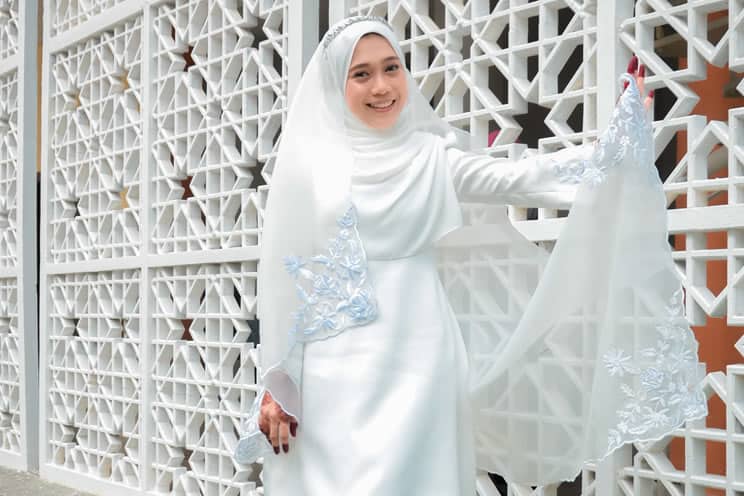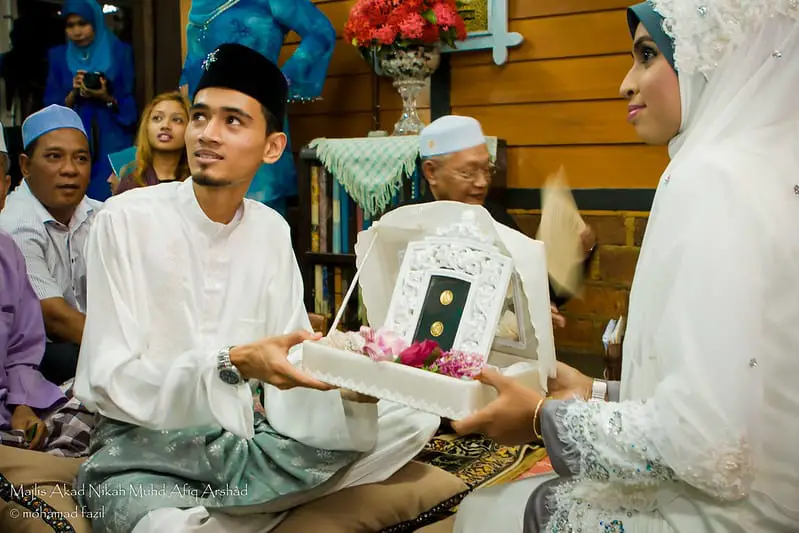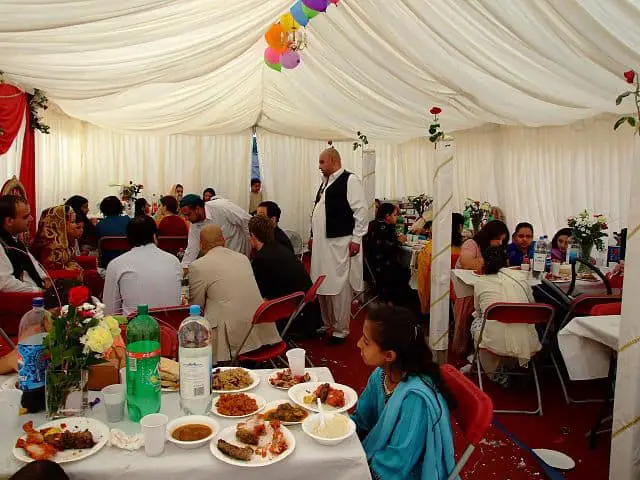
Recently, I was invited to a Muslim wedding and I learned that the Muslims takes the sacred wedding ceremonies very seriously. In a quest to uncover more, I embarked on an extensive research to find out what are the rituals involved in a Muslim wedding ceremony.
So, what are the steps of a Muslim wedding? A Muslim wedding comprises of thirteen wedding rituals. Each one has lots of significance in the celebration of the bond between the two souls and their families. These rituals or steps are normally conducted within three days to ensure that the symbolic rituals are fully covered. These rituals include:
- Salatul Ishtikara
- Imam Zamin
- Mangni
- Manjha
- Mehndi
- Sanchaq
- Baraat
- Arrival of the Groom
- Nikah
- Arsi Mushraf
- Rukhsat
- Walima
- Chauti
Variable bountiful cultures and customs are surrounding the wedding realm all over the world. And one of the most scintillating and colorful of them are the Muslim weddings. Islam is one of the most popular religions and has numerous unique traditions to follow in their wedding ceremonies. All Muslims are expected to marry by traditional Islamic law.
There exists pre-wedding ceremonies, wedding rituals as well as post wedding rituals at every Islamic wedding. Muslim weddings are always elaborate. Here are the rituals that Islamic weddings follow.
1. Salatul Ishtikara
The Salatul Ishtikara is a pre wedding ritual in which the imam performs a prayer to seek Allah’s blessings for the marriage. It is normally considered to be an official announcement of the marriage. This is an Islamic tradition that is rooted in the culture of the Shia.
The actual meaning of Ishtikara is asking what is best and is proper from Allah and leaving all of one’s affairs to Allah and having a good favorable opinion on Allah. This means that in all of anybody’s affairs of marriage, the individual supplicates to God and sincerely asks Him to make the path of marriage easy and to have a blessed outcome in marriage.
The Salatul Ishtikara by supplication before marriage takes precedence. It is recommended that before a believer performs even a smallest act, he or she should begin by supplicating to Allah. In hadiths, it has been emphasized that Salatul Ishtikara should be performed before any Muslim marriage is commenced.
This will guarantee the success of the marriage by glorifying and praising Allah coupled with humility and modesty towards Him. Performing this prayer means that the couple is asking to be guided to where prosperity lies.
2. Imam Zamin
The Imam Zamin ritual follows the Salatul Ishtikara. It basically involves a visit from the groom’s mom to the bride’s residence. She is expected to bring sweets and gifts as well as an ominous silver coin or gold.
It is normally wrapped in a silk scarf and usually tied around the wrist of the bride. This marks as a formal welcome and acceptance into the new family. Islamic cultures view the Imam Zamin as a form of sadaqah where fortune is expected in return.
Originally the coin that was used in Imam Zamin ritual was religiously meaningful because it had the name of the Imam minted on it. Nowadays, it does not matter if the coin bears a picture of Thomas Jefferson or George Washington because the only thing that has significance is the symbolism of the coin on the arm.
Ultimately, the historical and religious importance of the coin is observed across most Muslim cultures. It is a tradition that has been passed down through weddings. The tying of the coin around the wrist as a wish for the couples prosperity and that the wedding will be filled with good fortune.
3. Mangni
The Mangni ceremony is considered to be the engagement ceremony. In this ceremony, relatives and close friends gather to witness the ring exchanging ritual. Both the families shower themselves with gifts. It is a public declaration of the betrothal of the bride and groom.
Apart from the exchanging of gifts, a formal declaration of a wedding time and date is made. Traditionally, the welcoming of the bride’s family into the groom’s home is done. During the ceremony, a formally recognized commitment is done between the two parties getting engaged and vows are recited to solidify the engagement.
It is performed in the groom’s home where the bride’s family rings traditional sweets, wrapped dry fruits, gifts and tikka- a major traditional accessory with vermilion that is used to perform the Mangni ritual that is full of custom practices.
The bride’s family carries traditional material that is needed such as a silver tray with a few bowls of cereal, rice and a silver bowl including saffron, fourteen chucharey wrapped in a silver foil and well as a coconut that is wrapped in a golden leaf.
4. Manjha
The Manjha ceremony is a Muslim marriage equivalent of the Haldi ceremony. It is conducted before the wedding ceremony. The groom and his bride dress in yellow clothing in their respective homes and get smeared with a paste of sandalwood and turmeric in rosewater.
There exists numerous celebrations that should be followed, and then they are required to bat in holy water. They are not supposed to leave their respective homes until the marriage day.
The ladies of the house normally prepare the paste. The paste is applied on the bride’s hands, face and feet. Girls and women of the house and ones from the neighborhood sit and sing songs of the bride and the groom. The ceremony is filled with fun, mischievous activities and lots of enjoyment on this occasion.
The same ceremony is normally conducted in the groom’s house as well. The significance of this ceremony is to bless the couple with a long and strong relationship. Turmeric is used and is known to provide a radiant and natural glow on the skin. This makes sure that the bride becomes radiant and has glowing skin during their wedding.
5. Mehndi
The Mehndi ritual is very important in all Muslim weddings. It is used to symbolize endless sacrifice, love and bonding between the bride and groom. With the paste of henna, both the legs and hands of the bride and groom are decorated. Mehndi artists are normally appointed a few days before the occasion.
There exist numerous designs of Mehndi. The decoration is normally done at the bride’s and groom’s home. Other ladies and girls within both houses are expected to apply Mehndi on their hands.
It is believed that if the color of Mehndi of the bride is darker than the husbands, then the groom is more loving and caring. The designs made are normally new bridal Mehdi designs. The groom’s initials are usually hidden in the design and he is required to find it during the wedding night.
The ceremony is organized by the bride’s family bringing together other female components of both sides. While the ceremony is usually for female counterparts, male relatives are also invited to join in on the party. The main significance of applying henna is to utilize its natural medicinal herbal remedies.
6. Sanchaq
The Sanchaq pre wedding ritual where the groom’s family hand picks an outfit solely for the bride to wear on the day of the Nikah to add on beauty they shower the bride with lavish gifts along with the outfit of the bride.
The process of handing out gifts to the bride is known as the sanchaya. The male members of the groom’s family visit the bride’s family with gifts including sweets, bridal outfits and accessories and jewelry.
The dress for the bride comprises a Sharara along with a skirt as well as blouse. A dupatta is also needed to cover the head. The Sanchaq of nose ring (Nath), forehead ornament (Tika). Rings, make-up goods for the wedding (Suhag Pura) and Nuqals. Dry fruits are also required. Khawnas consist of a large pan of numerous articles like a clay pot (makta) that is filled with curd along with a fish that is tied to the neck of the pot.
This marks the last pre-wedding ceremony that signifies the affection, blessing and support of the male counterparts of the bride’s new home.
7. Baraat
The Baraat is a wedding procession that is taken out from the groom’s side on his wedding day. Although this ceremony has no religious significance, it is a tradition that is observed by many Muslims. It involves the travelling of the groom to the venue of the wedding ceremony on a mare with his friends and family celebrating along the way, often with song and dance.
The Music is lent by either a few dhol wale or a brass band or percussionists while the family and friends of the groom rejoice in happiness. The most exciting event of the wedding day is the entry of baraat. Today, the groom uses a properly decorated vehicle to reach the wedding venue.
The groom is usually escorted with male friends. A family friend of the bride’s family is required to escort him. The ritual is a splendid, loud gathering declaring that the wedding ceremony is going to commence in a few hours. It is required to tie the groom’s veil or sehra that is attached to his cloth turban. The baraatis all dress in matching turbans too.
8. Arrival of the Groom
The bride’s family members welcome the groom at the wedding venue. During this ceremony, the groom is served with a cold drink that he takes in the company of the bride’s brother or a relative brother figure. They spray rosewater or attar on the groom, and around him to create a beautiful path for him to enter.
A band plays traditional music to announce the arrival. The bride’s sister plays prank and welcomes the guest with flowers and rosewater that symbolizes the fragrance and purity of the divine.
The actual song and dance for welcoming the groom can go for hours depending on the enthusiasm of the welcoming group. The groom’s attire is tied with clothes made of flowers or beads. During the welcoming process it is the duty of the bride’s brother to make sure that the groom is well taken care of and is comfortable.
9. Nikah
The Nikah rituals the Muslim marriage ceremony. In Islamic law, the marriage contract is usually signed during the nikah ceremony and it is during this procession that the couple say, “I do.”
Traditionally the ritual takes place in a mosque with the imam officiating the ceremony. In Islamic tradition, the nikah is required to be as simple as possible to make sure that the couple is not placed in a financial burden.

The nikah ceremony marks a procession that makes sure that the Muslim couple is married under Islamic law. It is a prophetic requirement and the only way that a woman and a man can be married. The ceremony makes the wedding official because in the Islamic tradition it is not permissible for a couple to be intimate without a nikah. The Nikah legitimizes the union in front of God.
As with any marriage, the groom has to propose for the nikah process to begin. While in many cultures the man is often required to propose but in Islam a woman can sometimes propose. The qabool is the acceptance of the proposal.
During the time of proposal and acceptance, the couple is required to talk together in order to get them to know each other as long as the meeting takes place in public or within the proximity of a chaperon.
The ceremony is followed by the Nikah Nama. It involves the official marriage contract where the duties of the bride and groom, as dictated by the Quran, are recited in the presence of two witnesses each from the bride’s and groom’s families.
After the official contract has been signed, a Khutba is recited, followed by the vow as stipulated by the Quran. In the end, the elders perform durood that is basically the blessing on the new couple.
10. Arsi Mushraf
The Arsi Mushraf ritual is a splendid Islamic wedding ceremony wherein the couple steal a glance to look at each other, not directly but coyly through a mirror. A mirror is kept between the groom and the bride and the Quran is placed on top of it. The couple is required to look into the mirror where they see the reflection of their spouses. This ritual completes the nikah ceremony.
After this, the women are separated from the men. The first round of dinner is served to the guests and the couple. Once all the people in attendance have finished their meals, the groom and bride- still seated next to one another with their heads covered are instructed to read some prayers.
11. Rukhsat
The Rukhsat is the first post-wedding ritual. In this ritual the bride waves to say goodbye to her family. It is basically a very emotional moment. After the farewells and wishes, the father of the bride hands her over to the groom and asks him to take good care of his daughter.
The bride is then expected to leave the wedding venue with her husband and heads to her new home. The bride arrives at her new home, she is received with warmth by her mother in law. During this ritual the Holy Quran is normally placed on the bride’s head to symbolize her duties as a wife.
12. Walima
The walima is also known as the Dawat-e-dalimah is the second post wedding ceremony of any Muslim wedding. It is a lavish wedding banquet that is normally hosted by the groom’s family. Distant and immediate relatives, neighbors and friends are invited to feast. It is a grand wedding reception that is normally organized for the newlyweds to wish them a happy life as a married couple.

In the walima ceremony there is an endless supply of food and lots of dancing and music. Sweet drinks are also shared. Although it is essential to note that Muslim culture discourage the consumption of alcohol. The reception ensures that the bride and groom unwind. They also take the opportunity to get introduced to the extended family members and friends.
The bride and groom are normally treated as royalty and are showered with blessings and gifts. The walima marks the final public declaration of the marriage in the presence of family members as well as the whole community. It normally serves as the declaration that the marriage ceremony is done. It is usually the reception party.
13. Chauthi
On the fourth day from the day of the nikah ceremony, the couple is required to visit the bride’s family. The bride’s family greets the groom with lots of affection and is given lots of gifts. The bride is also gifted with a lot of gifts from the groom’s family as well. This Chauthi ceremony marks the end of all the formal Muslim wedding ceremonies between the two families.
Finally
Finally the above Muslim wedding traditions are so distinct from other wedding traditions and rituals. A typical Muslim wedding ceremony offers a plenty of beautiful experiences to relish. Some of these rituals are unique and are unforgettable.
All of these ceremonies require that all the attendees conform to the restrictions that are stipulated in Islamic law. A beautiful wedding ceremony must conform to the rituals above within the confines of Islamic law.
Photo Credits:
Nikah – Mohammed Fazil CC BY-SA 2.0
Walima – Lee Jordan, CC BY-SA 2.0, via Wikimedia Commons
